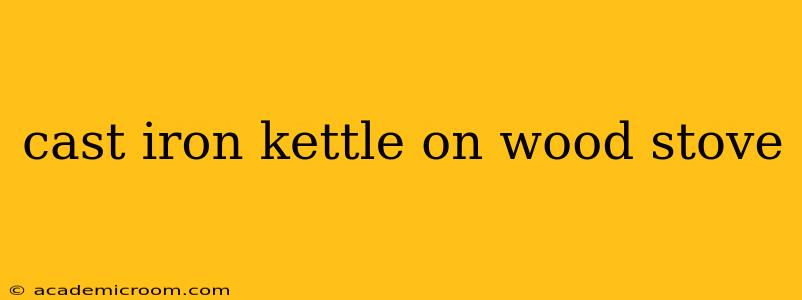The comforting sight and sound of a cast iron kettle simmering on a wood stove evokes a sense of warmth, nostalgia, and home-cooked goodness. For generations, cast iron kettles have been a staple in kitchens worldwide, particularly those heated by wood stoves. Their durability, heat retention, and even heating make them ideal for a variety of tasks, from brewing tea to making hearty stews. But using a cast iron kettle on a wood stove requires understanding its unique properties and taking appropriate precautions. This guide will explore the benefits, best practices, and common questions surrounding this classic combination.
Why Use a Cast Iron Kettle on a Wood Stove?
Cast iron kettles offer several advantages when used on a wood stove:
-
Superior Heat Retention: Cast iron's dense structure retains heat exceptionally well, ensuring your water stays hot for a longer period even after the stove's fire dies down. This is a significant advantage over other materials like stainless steel.
-
Even Heating: Unlike some materials that create hot spots, cast iron distributes heat evenly across its surface, preventing scorching and ensuring consistent temperature. This results in more evenly brewed tea or perfectly cooked porridge.
-
Durability: Cast iron kettles are built to last. With proper care, they can withstand years, even generations, of use, becoming cherished family heirlooms.
-
Flavor Enhancement (Some Believe): Some users believe that cast iron kettles can subtly enhance the flavor of certain beverages, infusing a slight mineral taste. This is a matter of personal preference.
-
Aesthetic Appeal: The rustic charm of a cast iron kettle adds a touch of traditional elegance to any kitchen setting, especially when paired with a wood stove.
How to Use a Cast Iron Kettle on a Wood Stove
Using a cast iron kettle on a wood stove is generally straightforward, but a few best practices can enhance your experience and prolong the life of your kettle:
-
Seasoning: Before first use, and periodically thereafter, season your cast iron kettle to create a protective layer that prevents rust and improves its non-stick properties. This involves applying a thin layer of oil and baking it in the oven.
-
Gentle Heating: Avoid placing a cold cast iron kettle directly onto a hot wood stove. Gradually increase the heat to prevent thermal shock, which can crack the kettle.
-
Water Level: Don't overfill the kettle. Leave enough space between the water level and the rim to prevent boiling over.
-
Careful Handling: Cast iron kettles get extremely hot. Use oven mitts or pot holders when handling them, especially when removing them from the stove.
-
Cleaning: Clean your kettle thoroughly after each use with warm, soapy water. Avoid using harsh detergents or abrasive scrubbers. Dry it completely before storing to prevent rust.
What are the Potential Dangers of Using a Cast Iron Kettle on a Wood Stove?
While generally safe, using a cast iron kettle on a wood stove presents some potential risks:
-
Burns: As mentioned, cast iron kettles become very hot. Always use caution and protective gear when handling them.
-
Thermal Shock: Exposing a cold kettle to intense heat can cause it to crack. Warm it gradually.
-
Uneven Heating (if improperly maintained): A poorly maintained kettle (lack of seasoning) might develop hot spots, leading to uneven cooking.
-
Rust: If not properly cleaned and dried, your kettle can rust.
How Do I Clean a Cast Iron Kettle After Use?
Cleaning your cast iron kettle is crucial for maintaining its longevity and preventing rust. After each use, follow these steps:
- Allow the kettle to cool slightly.
- Wash it with warm, soapy water using a soft sponge or cloth.
- Rinse thoroughly.
- Dry it completely with a clean towel or let it air dry completely before storing. Avoid leaving any water inside.
What Kind of Wood is Best for Heating a Cast Iron Kettle?
The type of wood used in your wood stove doesn't directly impact the kettle itself. However, hardwoods like oak and maple burn longer and produce more consistent heat, which is ideal for maintaining a gentle simmer in your kettle. Softer woods burn faster and may require more frequent attention.
Can I Use a Cast Iron Kettle on an Electric or Gas Stove?
Yes, you can use a cast iron kettle on an electric or gas stove, but be mindful of the heat level to prevent scorching. Wood stoves tend to provide a more controlled and even heat for simmering.
This guide should provide you with the knowledge and confidence to safely and effectively utilize your cast iron kettle on your wood stove, enjoying the warmth, functionality, and traditional charm this classic combination offers. Remember, proper care and maintenance are key to ensuring your kettle lasts for many years to come.
